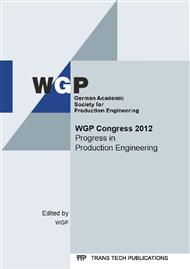[1]
König J.; Herstellung und Einsatz CVD-diamantbeschichteter Bohrgewindefräser. Berichte aus dem Produktionstechnischem Zentrum Berlin. Hrsg.: Uhlmann, E. Stuttgart: Fraunhofer IRB (2007) pp.1-2.
Google Scholar
[2]
Uhlmann E., Reimers W., Byrne F., Klaus M.; Analysis of tool wear and residual stress of CVD diamond coated cemented carbide tools in the machining of aluminium-silicon alloys. Production Engineering Research & Development (2010), 4, pp.203-209.
DOI: 10.1007/s11740-010-0213-x
Google Scholar
[3]
Bouzakis K.D., Michailidis N., Gerardis S., Kaatirtzoglou G., Lili E., Pappa M., Cremer R.; Application of the Impact Test to Predict Coated Tools' Cutting Performance in Miling Inconel 718. Advanced Engineering Materials (2008).
DOI: 10.1002/adem.200800065
Google Scholar
[4]
Genzel Ch., Denks I.A., Gibmeier J., Klaus M., Wagener G.; The Material Science Synchrotron Beamline EDDI for Energy-Dispersive Diffraction Analysis. Nucl. Instrum. Methods in Phys. Research (2007) A 578, pp.23-33.
DOI: 10.1016/j.nima.2007.05.209
Google Scholar
[5]
Eigenmann B., Scholtes B., Macherauch E.; Eine Mehrwellenlängenmethode zur röntgenographischen Analyse oberflächennaher Eigenspannungszustände in Keramiken. Mat. -wiss. u. Werkstofftechn. (1990) 21, pp.257-265.
DOI: 10.1002/mawe.19900210705
Google Scholar
[6]
Eigenmann B.; Röntgenographische Analyse inhomogener Spannungszustände in Keramiken, Keramik-Metall-Fügeverbindungen und dünnen Schichten. Dissertation Karlsruhe (1992).
Google Scholar
[7]
Genzel Ch., Stock C., Reimers W.; Application of Energy-Dispersive Diffraction to the Analysis of Multiaxial Residual Stress Fields in the Intermediate Zone between Surface and Volume. Mat. Sci. Eng. (2004) A372, pp.28-43.
DOI: 10.1016/j.msea.2003.09.073
Google Scholar
[8]
Ruppersberg H., Detemple I., Krier J.; Evaluation of Strongly Non-Linear Surface-Stress Fields σxx(z) and σyy(z) from Diffraction Experiments. phys. stat. sol. (a) (1989) 116, pp.681-687.
DOI: 10.1002/pssa.2211160226
Google Scholar
[9]
Ruppersber H., Detemple I.; Evaluation of the Complex Stress Field in a Ground Steel Plate from Energy Dispersive X-Ray Diffraction Experiments. phys. stat. sol. (a) (1989) 116, pp.681-687.
Google Scholar
[10]
Macherauch E., Müller P.; Das sin²y - Verfahren der röntgenographischen Spannnungsmessung. Z. angew. Physik (1961) 13, pp.305-312.
Google Scholar
[11]
Eigenmann B., Macherauch E.; Röntgenographische Untersuchung von Spannungszuständen in Werkstoffen. Teil III. Mat. -wiss. u. Werkstofftechn. (1996) 27, pp.426-437.
DOI: 10.1002/mawe.19960270907
Google Scholar


